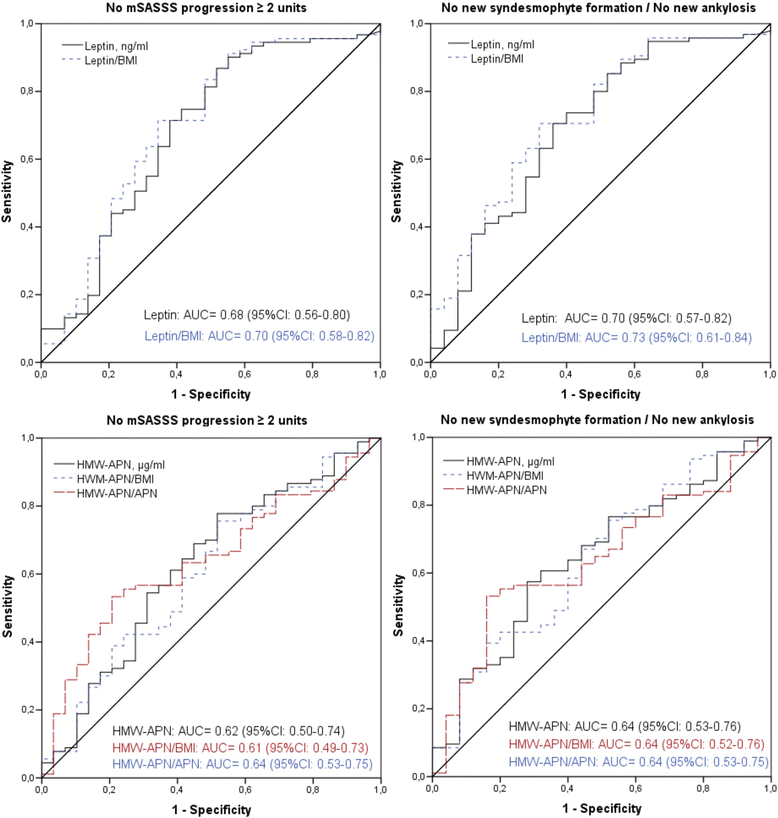Serum levels of leptin and high molecular weight adiponectin are inversely associated with radiographic spinal progression in patients with ankylosing spondylitis: results from the ENRADAS trial
- PMID: 28619118
- PMCID: PMC5471667
- DOI: 10.1186/s13075-017-1350-9
Serum levels of leptin and high molecular weight adiponectin are inversely associated with radiographic spinal progression in patients with ankylosing spondylitis: results from the ENRADAS trial
Abstract
Background: Previous research indicates a role of adipokines in inflammation and osteogenesis. Hence adipokines might also have a pathophysiological role in inflammation and new bone formation in patients with ankylosing spondylitis (AS). The aim of this study was to investigate the role of adipokine serum levels as predictors of radiographic spinal progression in patients with AS.
Methods: A total of 120 patients with definite AS who completed a 2-year follow up in the ENRADAS trial were included in the current study. Radiographic spinal progression was defined as: (1) worsening of the modified Stoke Ankylosing Spondylitis spine (mSASSS) score by ≥2 points and/or (2) new syndesmophyte formation or progression of existing syndesmophytes after 2 years. Serum levels of adipokines (adiponectin (APN) and its high molecular weight form (HMW-APN), chemerin, leptin, lipocalin-2, omentin, resistin, visfatin) were measured using enzyme-linked immunosorbent assays.
Results: There was a significant association between radiographic spinal progression and both leptin and HMW-APN. Baseline serum levels of both adipokines were lower in patients who showed radiographic spinal progression after 2 years. This association was especially evident in men; they had generally lower leptin and HMW-APN serum levels as compared to women. The inverse association between adipokines and radiographic spinal progression was confirmed in the logistic regression analysis: the odds ratios (OR) for the outcome "no mSASSS progression ≥2 points" were 1.16 (95% CI 1.03 to 1.29) and 1.17 (95% CI 0.99 to 1.38), for leptin and HMW-APN, respectively; for "no syndesmophyte formation/progression" the respective OR were 1.29 (95% CI 1.11 to 1.50) and 1.18 (95% CI 0.98 to 1.42), adjusted for the presence of syndesmophytes at baseline, C-reactive protein at baseline, sex, body mass index (BMI), non-steroidal anti-inflammatory drugs intake score over 2 years, and smoking status at baseline.
Conclusion: Serum leptin and HMW-APN predict protection from spinal radiographic progression in patients with AS. Women generally have higher leptin and HMW-APN serum levels that might explain why they have less structural damage in the spine as compared to male patients with AS.
Trial registration: EudraCT: 2007-007637-39. ClinicalTrials.gov, NCT00715091 . Registered on 14 July 2008.
Keywords: Adipokine; Adiponectin; Ankylosing spondylitis; Axial spondyloarthritis; Leptin; Radiographic progression; Syndesmophytes.
Figures

Similar articles
-
Serum adipokine levels in patients with ankylosing spondylitis and their relationship to clinical parameters and radiographic spinal progression.Arthritis Rheumatol. 2015 Mar;67(3):678-85. doi: 10.1002/art.38968. Arthritis Rheumatol. 2015. PMID: 25417763
-
Relationship between serum adipokine levels and radiographic progression in patients with ankylosing spondylitis: A preliminary 2-year longitudinal study.Medicine (Baltimore). 2017 Aug;96(33):e7854. doi: 10.1097/MD.0000000000007854. Medicine (Baltimore). 2017. PMID: 28816988 Free PMC article.
-
Added value of biomarkers compared with clinical parameters for the prediction of radiographic spinal progression in axial spondyloarthritis.Rheumatology (Oxford). 2019 Sep 1;58(9):1556-1564. doi: 10.1093/rheumatology/kez025. Rheumatology (Oxford). 2019. PMID: 30830164 Clinical Trial.
-
Modified stoke ankylosing spondylitis spinal score as an outcome measure to assess the impact of treatment on structural progression in ankylosing spondylitis.Rheumatology (Oxford). 2019 Mar 1;58(3):388-400. doi: 10.1093/rheumatology/key128. Rheumatology (Oxford). 2019. PMID: 29860356 Free PMC article. Review.
-
Effect of anti-tumor necrosis factor α treatment on radiographic progression in patient with ankylosing spondylitis: A systematic review and meta-analysis.Mod Rheumatol. 2019 May;29(3):503-509. doi: 10.1080/14397595.2018.1525017. Epub 2019 Jan 3. Mod Rheumatol. 2019. PMID: 30220240
Cited by
-
A five-year prospective study of spinal radiographic progression and its predictors in men and women with ankylosing spondylitis.Arthritis Res Ther. 2018 Aug 3;20(1):162. doi: 10.1186/s13075-018-1665-1. Arthritis Res Ther. 2018. PMID: 30075808 Free PMC article.
-
Leptin as an open secret in the physiopathology of rheumatic diseases.Clin Rheumatol. 2020 Feb;39(2):301-303. doi: 10.1007/s10067-019-04908-4. Epub 2020 Jan 11. Clin Rheumatol. 2020. PMID: 31927713 No abstract available.
-
Increased serum visfatin level is associated with fat deposition of the lumbar spine in ankylosing spondylitis patients.Heliyon. 2023 Dec 16;10(1):e23730. doi: 10.1016/j.heliyon.2023.e23730. eCollection 2024 Jan 15. Heliyon. 2023. PMID: 38192832 Free PMC article.
-
Adiponectin Deregulation in Systemic Autoimmune Rheumatic Diseases.Int J Mol Sci. 2021 Apr 15;22(8):4095. doi: 10.3390/ijms22084095. Int J Mol Sci. 2021. PMID: 33920997 Free PMC article. Review.
-
The Influence of Adipokines on Radiographic Damage in Inflammatory Rheumatic Diseases.Biomedicines. 2023 Feb 13;11(2):536. doi: 10.3390/biomedicines11020536. Biomedicines. 2023. PMID: 36831072 Free PMC article. Review.
References
Publication types
MeSH terms
Substances
Associated data
LinkOut - more resources
Full Text Sources
Other Literature Sources
Medical
Research Materials
Miscellaneous

